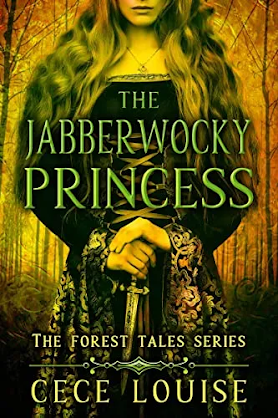Review: The Jabberwocky Princess
The Jabberwocky Princess is a book from The Forest Tales series by Cece Louise that I received from a promotion. It takes place right before Mazarine, another book I reviewed recently from the same series. The title suggests that it could be a new interpretation of Lewis Carroll's Alice's Adventures in Wonderland. Yet, aside from the presence of the Jabberwock and a few superficial literary references, the story is a generic fantasy adventure. This book does not hold a candle to the creativity and emotional intensity of ABC's Once Upon a Time in Wonderland, my favorite interpretation of Alice. In a way, it is even a bit disrespectful to Lewis Carroll by having the characters interpret direct quotes from his work as the rantings of a madman. Like Mazarine, the chapters alternate between two different perspectives. However, instead of swapping between two love interests, it focuses on dual female protagonists who, while different in their motivations, have similar internal monologues and personality traits, making it difficult to remember whose perspective I was reading from.
Similar to Mazarine, the main characters in The Jabberwocky Princess rely on stereotypical archetypes. Kainda is your average warrior princess from a common background who is willing to dress up as a man if it allows her to join the fight but does not personally identify as one. Meanwhile, Opal is a gentle princess who feels trapped by her stature and longs to be free to choose who to marry and make her own decisions. Both of these are characters that we have seen countless times in other fairy tale adaptations, and neither has enough unique traits to make this book stand out. Both of them have slow-burn love interests that take them a while to realize due to their innocence, which creates additional unnecessary confusion from the dual narration. Sometimes I'd be reading from Opal's perspective thinking it was Kainda or vice versa. The two romances seem like too ambitious of an undertaking for a story of this length. If the book had been about a lesbian romance between Kainda and Opal instead, the shorter length probably would have worked better.
The plot itself is as basic as can be. Princess Opal's kingdom has been ravaged for years by a monster that no one can identify, so her father offers her hand in marriage as a reward to anyone who can slay the beast. Meanwhile, in a nearby kingdom, Kainda is certain that she can identify the monster and figure out a way to defeat it using clues that her father had left behind in his past attempt. When Prince Ander announces that he is gathering some knights to join the quest to find and defeat the monster, Kainda makes her intentions known and convinces Ander to let her join the fight alongside her best friend, Larkin, a knight who is often overlooked by his peers. When they arrive in Opal's kingdom, Opal makes friends with Kainda and begins to develop feelings toward Larkin while Kainda and Prince Ander grow closer to each other through their mission to slay the monster. The mysterious beast that has been terrorizing the land is revealed to be the Jabberwock, a dangerous dragon with mind control powers.
The biggest flaw with this book is the backstory of Kainda's father. Before the book begins, he goes on a quest to slay the Jabberwock which he never returned from. However, he sent back a few key items with clues for Kainda to figure out how to defeat it herself. Not only are the clues unnecessarily cryptic when he could have just as easily written her a letter that tells her how to do it outright, but it also doesn't make sense that her father would have the time to prepare and manufacture this puzzle for her to solve before without having time to use the knowledge to defeat the Jabberwock himself. This is a much bigger problem than the unnecessary dual female protagonists. It felt like the author was trying to be clever by incorporating subtle references to Lewis Carroll's stories when the plot itself has nothing to do with Alice or Wonderland. It may have been better not to include them at all and instead work on explaining what happened to Kainda's father in a way that makes more sense.
While The Jabberwocky Princess holds the promise of a fantastical adventure inspired by Alice's Adventures in Wonderland, it ultimately falls short. The characters, with their familiar archetypes and predictable romances, lack the spark that ignites reader engagement. The plot, riddled with conveniences and inconsistencies, struggles to capture the whimsical essence of its namesake. While the dual female lead perspectives offer a change of pace, their similarities often blur the lines, leaving readers unsure whose journey they're witnessing. The cryptic clues left by Kainda's father and the forced Lewis Carroll references feel like misplaced attempts at depth, further muddying the narrative waters. This isn't to say the book is entirely devoid of merit. The message of female empowerment through Kainda's determination and Opal's yearning for autonomy holds potential. However, the underdeveloped world, predictable plot, and clichéd characters prevent it from reaching its full potential. If you seek a truly wondrous reimagining of Alice's world, look elsewhere. These Jabberwocky princesses, unfortunately, don't hold the key to unlocking that door.












Comments